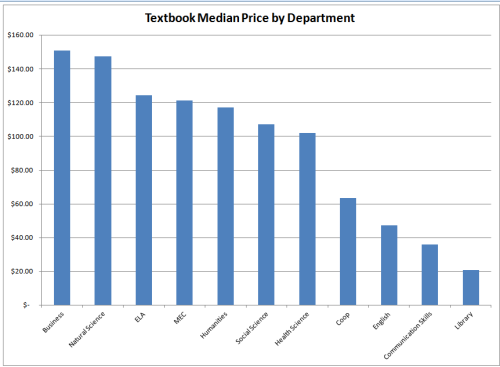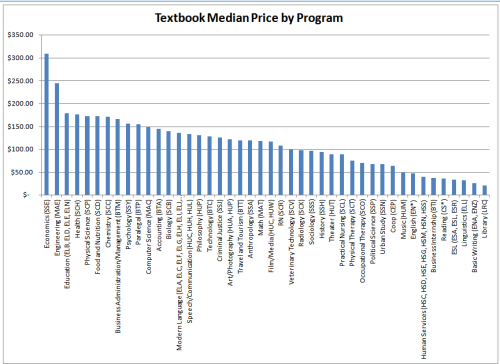Eben Upton is best known as the man behind the Raspberry Pi, a tiny, $25 computer designed to help turn kids into programmers. Upton priced it at $25 because he thought that’s around what an average textbook cost: “I now understand that’s an incorrect estimate. If we had a better idea of what school textbooks cost we would have had an easier job with the engineering over the years,” he joked to Wired years later.
It’s a funny story but also a sad story. Textbooks are expensive. More expensive than most non-students even realize.
OER From a Student Perspective
The above chart is national data. But textbook pricing is high, even when examined at the local level. I work at a public community college. We recently priced out our reserve collection, which is made up of textbooks for classes. We looked at data for 18 months of checkouts and found the average textbook in our study cost $109.36 and had a median price of $107.25. More than half of the programs represented in our reserve collection had a median textbook price of at least $100. Seven of the 11 academic departments have textbooks with a median cost of at least $100. We know 61% of LaGuardia students living with their parents have family income of less than $25,000, while 79% of students living away from their parents have family income of less than $25,000. How are these students supposed to afford prices like these? And how many would love to have the $25 textbook Upton thought students were stuck with?
If you’re wondering what your program costs, do a quick survey of your colleagues about their required textbooks. The results are probably comparable to what we see above.
OER: The Faculty View
Open education resources (OER) are an attempt to solve the textbook pricing problem by giving students and faculty great content at more reasonable prices — even free, which many consider to be the most reasonable price point of all. You’ll often hear OER also referred to as open textbooks, but it’s really so much more than freely accessible textbooks — it’s freely available class content. That means textbooks, but it also means course shells, syllabi, class assignments, and slide decks. So while OER discussions often focus on cost from a student perspective, it also has the potential to help faculty develop and refine their own course materials. Student cost savings is but one component of OER.
One of the best ways to describe OER comes from Hilton, Wiley, Stein and Johnson. They define openness in terms of ‘four Rs’: reuse; redistribution; revision; and remix:
- Reuse: This one could probably be called use, but it would ruin the alliteration of their thesis. Reuse is simply using content, which implies access, but also implies certain rights, like the ability to download content for later use. Thinking about this in CUNY terms, Blackboard, which so many of us use for managing our courses, makes it tough to share in a broad way. We can provide access to anyone who asks, but what if someone is from outside of CUNY? What if the person doesn’t know to ask for access? How can content be reused if it’s hidden behind a login and password?
- Redistribute: This also has access implications. It’s the right to freely share work, either with students or colleagues. OER content needs to be shareable. Also, while it’s generally accepted that OER material is always cost-free in digital form, David Wiley hypothesizes there’s money to be made in college bookstores printing OER material on-demand.
- Revise: OER is more about using static materials. An important part is the right to change material — to change it so it works for your students. We’ve all worked with a textbook and wished we could change certain parts of it. OER allows you to change those parts that don’t work for you. OER allows you to bend course materials to your pedagogy, rather than the other way around.
- Remix: This is the right to combine content from disparate sources. Maybe your ideal textbook is built from more than one textbook. Maybe your syllabus is based upon the best aspects of three or four syllabi. OER lets you build something new on the shoulders of your colleagues around the world. But it also allows faculty to build on your work, also.
OER isn’t easy, but it lends itself to scaffolding. It’s tough to instantly flip an existing course to entirely OER material, but it can be done incrementally. There’s no shortage of OER content; the challenge is not finding material, but rather filtering it. Having said that, a few places to begin discovering resources include:
- Support Centre for Open Resources in Education
- OER Commons
- Connexions
- OpenStax College
- Lumen Learning Open Classes
Faculty can also make their work available, either in pieces, via projects like the ones above, or by making an entire class publicly viewable using an open course tool, like Canvas. There are a lot of little things faculty can do to contribute to OER and to integrate it into their teaching.
The CUNY Open Education Resources Group has created a short, 20-minute introductory class designed to provide an actionable overview of OER. The class can found here. You can keep up with OER news on the CUNY OER blog.

This work is licensed under a Creative Commons Attribution-ShareAlike 4.0 International License.
Guest author Steve Ovadia is Web Services Librarian at LaGuardia Community College, CUNY.






Pingback: Slides from Open Educational Resources Panel | Open Access @ CUNY